Parts and Wholes: The Role of Animals in the Performance of Dolenjska Hallstatt Funerary Rites
Abstract
:1. Introduction
2. The Dolenjska Hallstatt Culture
3. Faunal Remains in Mortuary Contexts
4. Images of Animal Sacrifice
5. Discussion
5.1. Depositions of Animal Parts
5.2. Whole Animals
5.3. Animals as Amulets
6. Conclusions
Funding
Acknowledgments
Conflicts of Interest
Appendix A
| Site | Grave | Species | MNI 1 | Elements | Associated Human Burial (Probable Gender/Age) 2 |
|---|---|---|---|---|---|
| Molnik—Grmada | 17/6 | Horse | 1 | Tooth, humerus (L), ulna (L), radius, metacarpal (R), carpal (L), sesamoid, femur (R), metatarsal (L), calcaneus (L), tarsal (L), tarsal (R), phalanx | ♂/Adult |
| Pig | 1 | Humerus (L), cervical vertebra | |||
| Indeterminate 3 | N/A 4 | Cranial fragments, rib fragments, indeterminate elements | |||
| Vače—Apno | Finds above graves 12–24 | Megalodon shark | 1 | Tooth | N/A—stray find |
| Cattle | 1? | “Calves’ bones” (Starè 1955, p. 125) | |||
| Vače—Reber | Cremation Grave 2 | Deer (unknown species) | 1? | “The bones of the legs of a deer” (Starè 1955, p. 72) | ♀/Indt. |
| Zagorje ob Savi | Milač House/Grave with the Belt Plate | Horse | 1? | “The leg bones of a horse” (Draksler 2007, p. 131) | ♂/Adult |
| Magdalenska gora—Laščik | V/2 | Roe Deer | 1 | Metatarsals | ♀/Adult |
| V/5 | Horse | 1 | Upper M3 (R), lower M2 (R) | Indt./Indt. | |
| V/6-7-7a | Horse | 1 | Exact elements unknown, excavation photograph shows full articulated skeleton | ♂/Adult | |
| V/11 | Brown Bear | 1 | Claw | ♂/Adult | |
| V/19-20 | Indeterminate | 1 | Indeterminate fragment | ♂ ♂/Adult | |
| V/29 | Horse | 4 | Horse 1: Tibia (R) Horse 2: Cranial fragments, mandible, vertebrae, sacrum, scapulae, humeri, radii, ulnae, metacarpals, innominates, femurs, tibiae, astragalus and calcaneus (R), metatarsals Horse 3: Upper incisors, canines, premolars, molars, mandible, vertebrae, sacrum, rib fragments, scapula (L), humeri, radii, ulnae, metacarpals and phalanges, innominates, femurs, patellae, tibiae, metatarsals and phalanges Horse 4: Scapula fragment, femur (L), tibiae, astragalus (L), calcanei, metatarsal (R) | ♂ ♂/Adult | |
| Indeterminate | 1 | Pierced bone pendant | |||
| Magdalenska gora—Preloge | 2/13 | Horse | 1? | Mandible, teeth, unknown elements. Full skeleton implied (Tecco Hvala 2012, p. 31) | ♂/Adult |
| 2/57 | Horse | 1? | “Horse skeleton” (Tecco Hvala 2012, p. 31) | ♂/Indt. | |
| 2/69 | Unknown | 1? | Teeth | ♂/Indt. | |
| 2/88 | Horse | 1? | Teeth | Indt./Adult | |
| 13/87 | Dog | 1 | Canine tooth | ♀/Adult | |
| 13/119 | Horse | 1? | “Parts of a horse skeleton and teeth” (Tecco Hvala 2012, p. 31) | ♂/Adult | |
| 13/132 | Goat | 1 | Horn | ♂/Adult | |
| 13/163 | Sheep/Goat | 1? | “Bones of a caprovid” (Tecco Hvala 2012, p. 31) | ♀/Indt. | |
| II/17 | Bovid (indt. species) | 1? | “Two worked pieces of horn” (Hencken 1978, p. 15) | ♀/Adult | |
| IV/30 | Horse | 1? | Unknown 5 | ♂/Adult | |
| IV/32 | Horse | 1 | Rib, scapula, vertebrae | ♂/Indt. | |
| IV/40 | Horse | 1? | Unknown 6 | Indt./Indt. | |
| IV/43 | Cattle | 7 | Astragali (7 L and 2 R), calcanei (L and R), centrotarsal (L) | ♂/Indt. | |
| Horse | 1 | Cranial fragments, deciduous and permanent upper premolars, permanent upper molars, mandible, deciduous lower incisor, deciduous and permanent lower premolars, permanent lower molars, vertebrae, rib fragment, scapula fragments, humeri, radii, ulnae, carpals, metacarpals and phalanges, innominates, femurs, patellae, tibiae, astragali, calcanei, tarsals, metatarsals, phalanges | |||
| VII/29 | Sheep/Goat | 1 | Vertebra | Indt./Adult | |
| VII/38 | Roe Deer | 1 | Cranial fragment (L) | Indt./Adult | |
| VII/39 | Horse | 1? | “Some bones and teeth” (Hencken 1978, p. 58) | ♂/Adult | |
| VII/51 | Dog | 1 | Canine tooth | ♂/Indt. | |
| X/14 | Horse | 1 | Lower M3 (L) | Indt./Adult | |
| X/18 | Horse | 1 | Upper premolar (L) | ♀/Adult | |
| X/28 | Horse | 1 | Upper M3 (R) | ♂/Adult | |
| X/52 | Suid (indt. species) | 1? | Unknown 7 | ♂/Adult | |
| Stična—Gomile | 5/8 | Horse | 1 | Horse skeleton | None 8 |
| 5/10 | Horse | 1? | “Long and single flat bones” (Gabrovec and Kruh 2006a, p. 139) | Indt./Adult | |
| 48/33 9 | Horse | 1 | Horse skeleton | ♂/Adult | |
| Horse | 1 | Horse skeleton | |||
| 48/46 | Horse | 1 | Cranium | Indt./Indt. | |
| 48/Find 56 | Horse | 1? | “Broken bones—(from animals?)” (Gabrovec and Kruh 2006b, p. 52) | N/A—stray find | |
| 48/Horse Grave 71 | Horse | 1 | Horse skeleton | None 8 | |
| 48/Find 77 | Unknown | 1? | “Animal bones” (Gabrovec and Kruh 2006b, p. 63) | N/A—stray find | |
| 48/Find 93 | Unknown | 1? | “Animal bone fragments” (Gabrovec and Kruh 2006b, p. 72) | N/A—stray find | |
| 48/104 | Horse | 1 | “Chest and vertebrae” (Gabrovec and Kruh 2006b, p. 79) | ♂/Adult | |
| Unknown | N/A 10 | “Pile of burnt animal bones” (Gabrovec and Kruh 2006b, p. 79) | |||
| 48/115 | Unknown | 1? | “Animal bones” (Gabrovec and Kruh 2006b, p. 86) | Indt./Indt. | |
| III/2c | Horse | 1? | “Animal bones and several teeth” (Wells 1981, p. 54) | Indt./Indt. | |
| IV/16 | Horse | 1 | Upper and lower premolars and molars, rib fragment, scapula fragment (L), humerus fragment (R) | ♂/Adult | |
| IV/47 | Horse | 1 | Maxillary fragments, upper premolars and molars, tibia (R) | ♀/Indt. | |
| V/Isolated Finds | Horse | 1 | Teeth | N/A—stray find | |
| VIII/2 | Horse | 1 | Mandible | Indt./Indt. | |
| Medvedjek | I/36 | Horse | 1 | Maxillae, upper teeth, mandible, lower teeth | Indt./Indt. |
| Libna—Špiler | I/4 | Horse | 1 | Temporal, 21 teeth, mandible, two vertebrae | Indt./Indt. |
| I/6 | Horse | 1 | 12 teeth | ♂/Indt. | |
| I/Stray Find | Horse | N/A | Four molars | N/A—stray find | |
| Unknown | N/A 11 | Teeth | |||
| II/d | Horse | 1? | Teeth | ♂/Indt. | |
| II/1 | Horse | 1? | Cranium | ♂/Indt. | |
| III/Find 16 | Horse | N/A 12 | Teeth | N/A—stray find | |
| III/Find 25 | Horse | 1? | Cranium and teeth | N/A—stray find | |
| Libna—Volčanškova gomila | 1889–1890/aa | Horse | 1? | Cranium, ribs, upper limbs | ♂/Indt. |
| 1889–1890/i | Horse | 1? | Horse skeleton | Indt./Indt. | |
| 1889-1890/ Unknown provenience | Goat | 1? | Mandible, “other bones” (Guštin 1976, p. 30) | N/A—stray find | |
| Brezje pri Trebelnem | VI/1-2 13 | Horse | 3 | 1. Cranial fragments, mandible, vertebrae, humerus (L), radii, metacarpal (L), femurs 2. Right upper premolar and molars, mandible, atlas 3. Radius fragment (R) | Grave 1: ♂/Adult |
| Grave 2: Horse | |||||
| VI/3 | Horse | 1? | Horse skeleton | None 8 | |
| VI/5 | Horse | 1? | Cremated horse bones | ♂/Indt. | |
| Novo mesto—Kandija | VI/3 | Horse | 1 | Cranium | ♂ ♀/Adult |
| Novo mesto—Kapiteljska njiva | I/Central Grave | Horse | 1 | Maxilla (L), mandible (L), loose incisors | Indt./Adult |
| XVI/11 | Horse | 1 | Teeth, mandible fragments | Indt./Indt. | |
| XVI/34 | Horse | 1? | Teeth, other bones | ♀/Adult | |
| Novo mesto—Malenškova njiva | Malenškova gomila/1 | Horse | 1? | “Horse bones” (Dular 2007, p. 739 fn. 5) | ♂/Indt. |
| Malenškova gomila/3 | Horse | 1 | Cranium | ♂/Indt. | |
| Podzemelj—Vir | I/13 | Dog | 1? | “Skeleton of a large dog” (Barth 1969, p. 149) | Indt./Indt 14. |
References
- Argent, Gala. 2010. Do the Clothes Make the Horse? Relationality, Roles and Statuses in Iron Age Inner Asia. World Archaeology 42: 157–74. [Google Scholar] [CrossRef]
- Argent, Gala. 2012. Toward a Privileging of the Nonverbal: Communication, Corporeal Synchrony, and Transcendence in Humans and Horses. In Experiencing Animal Minds: An Anthology of Animal-Human Encounters. Edited by Julie A. Smith and Robert W. Mitchell. New York: Columbia University Press, pp. 111–28. [Google Scholar]
- Armstrong Oma, Kristin. 2013. Bronze Age Horses: Beyond Dualist Explanations. In Counterpoint: Essays in Archaeology and Heritage Studies in Honour of Professor Kristian Kristiansen. Edited by Sophie Bergerbrant and Serena Sabatini. Oxford: Archaeopress, pp. 141–46. [Google Scholar]
- Arnold, Bettina. 2001. The Limits of Agency in the Analysis of Elite Iron Age Celtic Burials. Journal of Social Archaeology 1: 210–24. [Google Scholar] [CrossRef]
- Arnold, Bettina. 2006. Gender and Archaeological Mortuary Analysis. In Reader in Gender Archaeology. Edited by Sarah Milledge Nelson. Lanham: AltaMira Press, pp. 137–70. [Google Scholar]
- Arnold, Bettina. 2010. Beasts of the Forest and Beasts of the Field: Animal Sacrifice, Hunting Symbolism, and the Master of Animals in Pre-Roman Iron Age Europe. In The Master of Animals in Old World Iconography. Edited by Derek B. Counts and Bettina Arnold. Budapest: Archaeolingua, pp. 193–210. [Google Scholar]
- Arnold, Bettina. 2011. The Illusion of Power, the Power of Illusion: Ideology and the Concretization of Social Difference in Early-Iron Age Europe. In Ideologies in Archaeology. Edited by Reinhard Bernbeck and Randall H. McGuire. Tucson: The University of Arizona Press, pp. 151–72. [Google Scholar]
- Azzaroli, Augusto. 1980. Venetic Horses from Iron Age burials at Padova. Rivista di Scienze Preistoriche 35: 281–308. [Google Scholar]
- Barth, Fritz Eckart. 1969. Die hallstattzeitlichen Grabhügel im Bereiche des Kutscher bei Podsemel (Slowenien). Bonn: Rudolph Habelt Verlag GMBH. [Google Scholar]
- Bartosiewicz, László. 1991. Faunal Material from Two Hallstatt Period Settlements in Slovenia. Arheološki vestnik 42: 199–206. [Google Scholar]
- Bartosiewicz, László. 1996. Continuity in the Animal Keeping of Hallstatt Period Communities in Slovenia. In Die Osthallstattkultur: Akten des Internationalen Symposiums, Sopron, 10–14 Mai 1994. Edited by Erzsébet Jerem and Andreas Lippert. Budapest: Archaeolingua, pp. 29–35. [Google Scholar]
- Bartosiewicz, László. 1999a. A Systematic Review of Astragalus Finds from Archaeological Sites. In Pannonia and Beyond. Studies in Honour of László Barkóczi. Edited by Andrea H. Vaday. Budapest: Archaeological Institute of the Hungarian Academy of Sciences, pp. 37–44. [Google Scholar]
- Bartosiewicz, László. 1999b. Recent Developments in Archaeozoological Research in Slovenia. Arheološki vestnik 50: 311–22. [Google Scholar]
- Basson, P. A., and J. M. Hofmeyer. 1973. Mortalities Associated with Wildlife Capture Operations. In The Capture and Care of Wild Animals. Edited by E. Young. Cape Town: Human & Rousseau, pp. 151–60. [Google Scholar]
- Bock, Bettina B., M. M. van Huik, Madeleine Prutzer, Florence Kling Eveillard, and Anne-Charlotte Dockes. 2007. Farmers’ relationship with different animals: The importance of getting close to the animals. Case studies of French, Swedish and Dutch cattle, pig and poultry farmers. International Journal of Sociology of Food and Agriculture 15: 108–25. [Google Scholar]
- Bökönyi, Sándor. 1968. Data on Iron Age Horses of Central and Eastern Europe. In Mecklenburg Collection, Part I. Edited by Hugh Hencken. Cambridge: The Peabody Museum, pp. 1–71. [Google Scholar]
- Bökönyi, Sándor. 1994. Analiza živalskih kosti/Die Tierknochenfunde der Siedlung. In Stična I: Naselbinska Izkopavanja/Siedlungsausgrabungen. Edited by Stane Gabrovec. Ljubljana: Narodni Muzej Slovenije, pp. 190–213. [Google Scholar]
- Bökönyi, Sándor. n.d. Letter to Hugh Hencken. Mecklenburg Collection. Box 4, Folder 5. Cambridge: Peabody Museum, Harvard University.
- Boyd, Michael J. 2014. The materiality of performance in Mycenaean funerary practices. World Archaeology 46: 192–205. [Google Scholar] [CrossRef] [Green Version]
- Boyd, Brian. 2017. Archaeology and Human–Animal Relations: Thinking through Anthropocentrism. Annual Review of Anthropology 46: 299–316. [Google Scholar] [CrossRef]
- Božič, Dragan. 2009. A Hallstatt grave containing a cuirass, excavated near Stična by the Duchess of Mecklenburg in 1913: The reliability of grave groups from the Mecklenburg Collection. Arheološki vestnik 60: 63–95. [Google Scholar]
- Brittain, Marcus, and Oliver Harris. 2010. Enchaining arguments and fragmenting assumptions: Reconsidering the fragmentation debate in archaeology. World Archaeology 42: 581–94. [Google Scholar] [CrossRef]
- Brück, Joanna. 1999. Ritual and Rationality: Some Problems of Interpretation in European Archaeology. European Journal of Archaeology 2: 313–44. [Google Scholar] [CrossRef]
- Brumfiel, Elizabeth M. 2006. Methods in Feminist and Gender Archaeology: A Feeling for Difference—And Likeness. In Handbook of Gender in Archaeology. Edited by Sarah Milledge Nelson. Lanham: AltaMira Press, pp. 31–58. [Google Scholar]
- Burmeister, Stefan. 2000. Geschlecht, Alter und Herrschaft in der Späthallstattzeit Württembergs. Tübinger Schriften zur Ur- und Frühgeschichtlichen Archäologie 4. München: Waxmann Münster. [Google Scholar]
- Calder, Louise. 2011. Cruelty and Sentimentality: Greek Attitudes to Animals, 600–300 BC. Studies in Classical Archaeology V. BAR International Series 2225. Oxford: Archaeopress. [Google Scholar]
- Carstens, Anne Marie. 2005. To Bury a Ruler: The Meaning of the Horse in Aristocratic Burials. In Cyprus: Religion and Society from the Late Bronze Age to the End of the Archaic Period. Proceedings of an International Symposium on Cypriote Archaeology, Erlangen, 23–24 July 2004. Edited by Vassos Karageorghis, Hartmut Matthäus and Sabine Rogge. Möhnesee-Wamel: Bibliopolis, pp. 57–76. [Google Scholar]
- Chapman, John C. 2000a. Fragmentation in Archaeology: People, Places and Broken Objects in the Prehistory of South-Eastern Europe. London and New York: Routledge. [Google Scholar]
- Chapman, John C. 2000b. Tension at funerals: Social practices and the subversion of community structure in later Hungarian prehistory. In Agency in Archaeology. Edited by Marcia-Anne Dobres and John E. Robb. London and New York: Routledge, pp. 169–95. [Google Scholar]
- Chapman, John C., and Bisserka Gaydarska. 2007. Parts and Wholes: Fragmentation in Prehistoric Context. Oxford: Oxbow. [Google Scholar]
- Choyke, Alice M. 2010. The Bone is the Beast: Animal Amulets and Ornaments in Power and Magic. In Anthropological Approaches to Zooarchaeology: Complexity, Colonialism, and Animal Transformations. Edited by Douglas V. Campana, Pamela Crabtree, Susan D. de France, Justin Lev-Tov and Alice M. Choyke. Oxford: Oxbow Books, pp. 197–209. [Google Scholar]
- Clutton-Brock, Juliet. 1981. Domesticated Animals from Early Times. Austin: University of Texas Press. [Google Scholar]
- Dandoy, Jeremiah R. 2006. Astragali through Time. In Integrating Zooarchaeology. Proceedings of the 9th ICAZ Conference, Durham 2002. Edited by Mark Maltby. Oxford: Oxbow, pp. 131–37. [Google Scholar]
- De Grossi Mazzorin, Jacopo, and Claudia Minniti. 2013. Ancient use of the knuckle-bone for rituals and gaming piece. Anthropozoologica 48: 371–80. [Google Scholar] [CrossRef]
- Draksler, Matej. 2007. Območje Zagorja ob Savi v prazgodovini/Das Gebiet von Zagorje ob Savi in der Vorgeschichte. Arheološki vestnik 58: 121–55. [Google Scholar]
- Dular, Janez. 2003. Halštatske Nekropole Dolenjske/Die Hallstattzeitlichen Nekropolen in Dolenjsko. Opera Instituti Archaeologici Sloveniae 6. Ljubljana: Zalžoba ZRC. [Google Scholar]
- Dular, Janez. 2007. Pferdegräber und Pferdebestattungen in der hallstattzeitlichen Dolenjsko-Gruppe. In Scripta Praehistorica in Honorem Biba Teržan. Edited by Martina Blečić, Matija Črešnar, Bernhard Hänsel, Anja Hellmuth, Elke Kaiser and Carola Metzner-Nebelsick. Ljubljana: Narodni muzej Slovenije, Situla 44. pp. 737–52. [Google Scholar]
- Dular, Janez, and Borut Križ. 1990. Železnodobno naselje in grobišče v Brezjah pri Trebelnem/Die eisenzeitliche Siedlung und Nekropole in Brezje bei Trebelno. Arheološki vestnik 41: 531–56. [Google Scholar]
- Dular, Janez, and Sneža Tecco Hvala. 2007. South-Eastern Slovenia in the Early Iron Age: Settlement—Economy—Society/Jugovzhodna Slovenija v Starejši Železni dobi: Poselitev, Gospodarstvo, Družba. Opera Instituti Archaeologici Sloveniae 12. Ljubljana: Založba ZRC. [Google Scholar]
- Eibner, Alexandrine. 1981. Darstellungsinhalte in der Kunst der Hallstattkultur: Gedanken zum "überhöhten" Leben im Situlenbereich und Osthallstattkreis. In Die Hallstattkultur. Bericht über das Symposium in Steyr 1980 aus Anlaß der Internationalen Ausstellung des Landes Oberösterreich. Edited by Clemens Eibner. Linz: Kommission Beim Oo. Landesverlag, pp. 261–96. [Google Scholar]
- Ekroth, Gunnel. 2014. Animal Sacrifice in Antiquity. In The Oxford Handbook of Animals in Classical Thought and Life. Edited by Gordon Lindsay Campbell. Oxford: Oxford University Press, pp. 324–54. [Google Scholar]
- Fahlander, Fredrik, and Terje Oestigaard. 2008. The Materiality of Death: Bodies, Burials, Beliefs. In The Materiality of Death: Bodies, Burials, Beliefs. Edited by Fredrik Fahlander and Terje Oestigaard. Oxford: Archaeopress, pp. 1–16. [Google Scholar]
- Fowler, Murray E. 1995. Restraint and Handling of Wild and Domestic Animals. Ames: Iowa State University Press. [Google Scholar]
- Frey, Otto Hermann. 1991. “Celtic Princes” in the Sixth Century B.C. In The Celts. Edited by Sabatino Moscati, Otto Hermann Frey, Venceslas Kruta, Barry Raftery and Miklós Szabó. New York: Rizzoli, pp. 74–92. [Google Scholar]
- Frey, Otto-Herman. 2011. The World of Situla Art. In The Barbarians of Ancient Europe: Realities and Interactions. Edited by Larissa Bonfante. Cambridge: Cambridge University Press, pp. 282–312. [Google Scholar]
- Frie, Adrienne C. 2016. Assembling animals: Actual, figural, and imagined. In Incomplete Archaeologies: Assembling Knowledge in the Past and Present. Edited by Emily Miller Bonney, Kathryn J. Franklin and James A. Johnson. Oxford: Oxbow Books, pp. 64–83. [Google Scholar]
- Frie, Adrienne C. 2017. Cultural Constructions of Nature: Animal Representation and Use in Early Iron Age Southeastern Slovenia. Ph.D. dissertation, University of Wisconsin-Milwaukee, Milwaukee, WI, USA. [Google Scholar]
- Frie, Adrienne C. 2018a. Horses and the embodiment of elite masculinity in the Dolenjska Hallstatt culture. Oxford Journal of Archaeology 37: 25–44. [Google Scholar] [CrossRef]
- Frie, Adrienne C. 2018b. Insignia of power: Bird imagery on artefacts of hierarchy and ritual in Iron Age Dolenjska (SE Slovenia). Documenta Praehistorica XLV: 166–78. [Google Scholar] [CrossRef] [Green Version]
- Frie, Adrienne C. 2019. Extraordinary Creatures: The Role of Birds in Early Iron Age Slovenia. Environmental Archaeology 24: 400–10. [Google Scholar] [CrossRef]
- Gabrovec, Stane. 1966. Zur Halstattzeit in Slowenien. Germania 44: 1–48. [Google Scholar]
- Gabrovec, Stane. 1976. Zum Beginn der Hallstattzeit in Slowenien. In Festschrift für Richard Pittoni zum siebzigsten Geburtstag. Edited by Herbert Mitscha-Märheim, Herwig Friesinger and Helga Kerchler. Wien and Horn: Franz Deuticke & Ferdinand Berger und Söhne OHG, pp. 588–600. [Google Scholar]
- Gabrovec, Stane. 1999. 50 Jahre Archäologie der älteren Eisenzeit in Slowenien/50 let arheologije starejše železne dobe v Sloveniji. Arheološki vestnik 50: 145–88. [Google Scholar]
- Gabrovec, Stane, ed. 2006. Stična II/1. Gomile Starejše Železne dobe/Grabhügel aus der Aelteren Eisenzeit. Katalogi in Monografije 37. Ljubljana: Narodni muzej Slovenije. [Google Scholar]
- Gabrovec, Stane, and Ana Kruh. 2006a. Gomila 5/Grabhügel 5. In Stična II/1. Gomile Starejše Železne dobe/Grabhügel aus der Aelteren Eisenzeit. Edited by Stane Gabrovec. Katalogi in Monografije 37. Ljubljana: Narodni muzej Slovenije, pp. 130–53. [Google Scholar]
- Gabrovec, Stane, and Ana Kruh. 2006b. Gomila 48/Gräbhugel 48. In Stična II/1. Gomile Starejše Železne Dobe/Grabhügel aus der Aelteren Eisenzeit. Edited by Stane Gabrovec. Katalogi in Monografije 37. Ljubljana: Narodni muzej Slovenije, pp. 14–129. [Google Scholar]
- Gabrovec, Stane, and Biba Teržan, eds. 2010. Stična II/2. Gomile starejše železne dobe. Razprave/Grabhügel aus der alteren Eisenzeit. Studien. Katalogi in Monografije 38. Ljubljana: Narodni Muzej Slovenije. First published 2008. [Google Scholar]
- Game, Ann. 2001. Riding: Embodying the Centaur. Body and Society 7: 1–12. [Google Scholar] [CrossRef]
- Gruškovnjak, Luka. 2016. Grobovi z živalskimi kostmi v času starejše železne dobe v Sloveniji. Master’s dissertation, University of Ljubljana, Ljubljana, Slovenia. [Google Scholar]
- Guštin, Mitja. 1976. Libna. Posavski muzej Brežice Knjiga 3. Brežice: Posavski muzej Brežice. [Google Scholar]
- Guštin, Mitja, and Biba Teržan. 1975. Malenškova gomila v Novem mestu: Prispevek k ponavanju povezav med jugozhodnim alpskim svetom, severozahodnim Balkanom in južno Panonijo v starejši želeni dobi. Arheološki vestnik 26: 188–202. [Google Scholar]
- Hamilakis, Yannis, and Eleni Konsolaki. 2004. Pigs for the Gods: Burnt Animal Sacrifices as Embodied Rituals at a Mycenaean Sanctuary. Oxford Journal of Archaeology 23: 135–51. [Google Scholar] [CrossRef]
- Hamilakis, Yannis, and Nick J. Overton. 2013. A Multi-Species Archaeology. Archaeological Dialogues 20: 159–73. [Google Scholar] [CrossRef]
- Härke, Heinrich. 2014. Grave goods in early medieval burials: Messages and meanings. Mortality 19: 41–60. [Google Scholar] [CrossRef]
- Hencken, Hugh. 1978. The Iron Age Cemetery of Magdalenska Gora in Slovenia. Mecklenburg Collection Papers, Bulletin 32. Cambridge: Harvard University Press, American School of Prehistoric Research. [Google Scholar]
- Horard-Herbin, Marie-Pierre, Anne Tresset, and Jean-Denis Vigne. 2014. Domestication and uses of the dog in western Europe from the Paleolithic to the Iron Age. Animal Frontiers 4: 23–31. [Google Scholar] [CrossRef] [Green Version]
- Insoll, Timothy. 2010. Talensi animal sacrifice and its archaeological implications. World Archaeology 42: 231–44. [Google Scholar] [CrossRef] [Green Version]
- Kimmig, Wolfgang. 1991. The Heuneburg Hillfort and the Proto-Celtic Princely Tombs of Upper Rhineland. In The Celts. Edited by Sabatino Moscati, Otto Hermann Frey, Venceslas Kruta, Barry Raftery and Miklós Szabó. New York: Rizzoli, pp. 114–15. [Google Scholar]
- Kmeťová, Petra. 2013a. “Masters of Horses” in the West, “Horse Breeders” in the East? On the Significance and Position of the Horse in the Early Iron Age Communities of the Pannonian Basin. In Interpretierte Eisenzeiten. Fallstudien, Methoden, Theorie. Tagungsbeiträge der 5. Linzer Gespräche zur interpretativen Eisenzeitarchäologie. Edited by Raimund Karl and Jutta Leskovar. Linz: Oberösterreichischen Landesmuseum, pp. 278–58. [Google Scholar]
- Kmeťová, Petra. 2013b. The Spectacle of the Horse: On Early Iron Age Burial Customs in the Eastern-Alpine Hallstatt Region. Archaeological Review from Cambridge 28: 67–81. [Google Scholar]
- Kmeťová, Petra. 2018. “And four strong-necked horses he threw swiftly on the pyre…” On human-horse relationship in the Early Iron Age Central Europe from the perspective of interregional contacts. In ΕΥΔAΙΜΩΝ. Studies in Honour of Jan Bouzek. Edited by Peter Pavúk, Věra Klontza-Jaklová and Anthony Harding. Prague: Faculty of Arts, Charles University, Opera Facultatis Philosophicae Universitatis Carolinae Pragensis, vol. XVIII, pp. 267–89. [Google Scholar]
- Kmeťová, Petra, and Susanne Stegmann-Rajtár. 2014. Zur symbolischen Bestattung von Pferdeschädeln in Gräbern der späten Urnenfelder- und älteren Hallstattzeit/K simboliki konjskih lobanj v grobovih iz poznega žarnogrobiščnega in starejšega halštatskega obdobja (Povzetek). In Studia Praehistorica in Honorem Janez Dular. Edited by Sneža Tecco Hvala. Opera Instituti Archaeologici Sloveniae 30. Ljubljana: Založba ZRC, pp. 149–66. [Google Scholar]
- Knez, Tone. 1993. Novo mesto III. Kapiteljska Njiva. Knežja Gomila/Novo mesto III. Kapiteljska Njiva. Fürstengrabhügel. Carniola archaeologica 3. Novo mesto: Dolenjski muzej. [Google Scholar]
- Knez, Tone, and Stanko Škaler. 1968. Halštatska gomila na Libni/Der Hallstatt-Grabhügel auf der Libna. Arheološki vestnik XIX: 239–72. [Google Scholar]
- Kossack, Georg. 1998. Horse and Wagon during the Early Iron Age in Central Europe. Technical Considerations, Nature of Evidence and Conceptual Content. In Towards Translating the Past. Georg Kossack—Selected Studies in Archaeology. Ten Essays from the Year 1974 to 1997. Edited by Bernhard Hänsel and Anthony F. Harding. Rahden: Verlag Marie Leidorf GmbH, pp. 97–106. [Google Scholar]
- Krausse, Dirk. 2007. The “Celtic Prince” of Hochdorf: Village-Elder or Sacred King? Pretense and Reality of the So-Called “Cultural Anthropological” Hallstatt Archaeology. In The Celtic World: Critical Concepts in Historical Studies. Edited by Raimund Karl and David Stifter. London and New York: Routledge, pp. 197–229. [Google Scholar]
- Križ, Borut. 1997. Kapiteljska njiva: Novo mesto. Katalog Arheološke Razstave. Novo mesto: Dolenjski muzej. [Google Scholar]
- Križ, Borut. 2012. Odsevi Prazgodovine v bronu: Situlska umetnost Novega mesta/Reflections of Prehistory in Bronze: The Situla Art of Novo mesto. Novo mesto: Dolenjski muzej. [Google Scholar]
- Križ, Borut, Mojca Jereb, and Biba Teržan. 2014. Kapiteljska njiva. In Absolutno Datiranje Bronaste in železne dobe na Slovenskem/Absolute Dating of the Bronze and Iron Ages in Slovenia. Edited by Biba Teržan and Matija Črešnar. Katalogi in Monografije 40. Ljubljana: Univerza v Ljubljani & Narodni muzej Slovenije, pp. 473–84. [Google Scholar]
- Kromer, Karl. 1959. Brezje: Halštatske Gomile z Brezij pri Trebelnem/Hallstättische Hügelgräber aus Brezje bei Trebelno. Arheološki katalogi Slovenije 2. Ljubljana: Narodni muzej Slovenije. [Google Scholar]
- Kromer, Karl. 1980. Das Situlenfest: Versuch einer Interpretation der Darstellungen auf figural verzierten Situlen. In Zbornik Posvečen Stanetu Gabrovcu ob Šestdesetletnici. Edited by Peter Petru. Ljubljana: Narodni muzej Slovenije, pp. 225–40. [Google Scholar]
- Kuzmina, Elena E. 2006. Mythological Treatment of the Horse in Indo-European Culture. In Horses and Humans: The Evolution of Human-Equine Relationships. Edited by Sandra L. Olsen, Susan Grant, Alice M. Choyke and László Bartosiewicz. Oxford: Archaeopress, pp. 263–70. [Google Scholar]
- Laharnar, Boštjan, and Peter Turk. 2018. Iron Age Stories from the Crossroads. Ljubljana: Narodni muzej Slovenije. [Google Scholar]
- Leghissa, Elena. 2015. Način okraševanja keramike ljubljanske kulture in pramenaste keramike—Eksperimentalna arheologija/Decorating the pottery of the Ljubljana culture and the Litzen pottery—An experimental archaeology case study. Arheološki vestnik 66: 275–92. [Google Scholar]
- Lücke, Judith. 2007. Das Lappenbeil im mittleren Alpenraum als Motiv in bildlichen und plastischen Darstellungen. In Scripta Praehistorica in Honorem Biba Teržan. Edited by Martina Blečić, Matija Črešnar, Bernhard Hänsel, Anja Hellmuth, Elke Kaiser and Carola Metzner-Nebelsick. Ljubljana: Narodni muzej Slovenije, Situla 44. pp. 597–601. [Google Scholar]
- Lucke, Wolfgang, and Otto-Herman Frey. 1962. Die Situla in Providence (Rhode Island). Ein Beitrag zur Situlenkunst des Osthallstattkreises. Römisch-germanische Forschungen 26. Berlin: de Gruyter. [Google Scholar]
- Mlekuž, Dimitrij. 2013. The Birth of the Herd. Society & Animals 21: 150–61. [Google Scholar] [CrossRef] [Green Version]
- Morey, Darcy F. 2006. Burying key evidence: The social bond between dogs and people. Journal of Archaeological Science 33: 158–75. [Google Scholar] [CrossRef]
- Morris, James. 2008. Associated bone groups; one archaeologist’s rubbish is another’s ritual deposition. In Changing Perspectives on the First Millennium BC. Edited by Oliver Davis, K. Waddington and Niall Sharples. Oxford: Oxbow, pp. 83–98. [Google Scholar]
- Morris, James. 2011. Investigating Animal Burials: Ritual, Mundane and Beyond. BAR British Series 535. Oxford: Archaeopress. [Google Scholar]
- Morris, James. 2012. Animal “Ritual” Killing: From Remains to Meanings. In The Ritual Killing and Burial of Animals: European Perspectives. Edited by Aleksander Pluskowski. Oxford: Oxbow Books, pp. 8–21. [Google Scholar]
- Nilsson Stutz, Liv, and Sarah Tarlow. 2013. Beautiful Things and Bones of Desire. In The Oxford Handbook of the Archaeology of Death and Burial. Edited by Liv Nilsson Stutz and Sarah Tarlow. Oxford: Oxford University Press, pp. 1–14. [Google Scholar]
- Parker Pearson, Mike. 1999. The Archaeology of Death and Burial. Texas College Station: A&M University Press. [Google Scholar]
- Pauli, Ludwig. 1975. Keltischer Volksglaube: Amulette und Sonderbestattungen am Dürrnberg bei Hallein und im Eisenzeitlichen Mitteleuropa. München: C. H. Beck. [Google Scholar]
- Pilaar Birch, Suzanne E. 2018. Introduction. In Multispecies Archaeology. Edited by Suzanne E. Pilaar Birch. London: Routledge, pp. 1–7. [Google Scholar]
- Pluskowski, Aleksander. 2012. The Ritual Killing and Burial of Animals. In The Ritual Killing and Burial of Animals: European Perspectives. Edited by Aleksander Pluskowski. Oxford: Oxbow, pp. 1–7. [Google Scholar]
- Puš, Ivan. 1971. Žarnogrobiščna Nekropola na Dvorišču SAZU v Ljubljani: Izkopavanja v letih 1964–1956/Nekropole der Urnenfelderkultur im Hof der Slowenischen Akademie der Wissenschaften und Künste in Ljubljana: Ausgrabungen in den jahren 1964–1965. Razprave/Dissertationes VII/1. Ljubljana: Slovenska Akademija Znanosti in Umetnosti. [Google Scholar]
- Puš, Ivan. 1982. Prazgodovinsko žarno Grobišče v Ljubljani/Das Vorgeschichtliche Urnengräberfeld in Ljubljana. Razprave/Dissertationes XIII/2. Ljubljana: Slovenska Akademija Znanosti in Umetnosti. [Google Scholar]
- Rask, Katie A. 2014. Etruscan Animal Bones and Their Implications for Sacrificial Studies. History of Religions 53: 269–312. [Google Scholar] [CrossRef]
- Škvor Jernejčič, Brina. 2014. Žarna nekropola v Ljubljani in preobrazba Ljubljanske skupine na prehodu iz bronaste v železno dobo. Ph.D. dissertation, Univerza v Ljubljani, Ljubljana, Slovenia. [Google Scholar]
- Škvor Jernejčič, Brina. 2017. Graves from the Early Hallstatt Period at Molnik. In Molnik pri Ljubljani v Železni dobi/The Iron Age Site at Molnik near Ljubljana. Edited by Sneža Tecco Hvala. Opera Instituti archaeologici Sloveniae 36. Ljubljana: Založba ZRC, pp. 140–53. [Google Scholar]
- Škvor Jernejčič, Brina, and Borut Toškan. 2018. Ritual use of dogs and wolves in the Late Bronze and Early Iron Age in the South-Eastern Alpine region. New evidence from the archaeo(zoo)logical perspective. In Animal Symbolisé, Animal Exploité: Du Paléolithique à la Protohistoire. Edited by Sandrine Costamagno, Lionel Gourichon, Catherine Dupont, Olivier Dutour and Denis Vialou. Paris: Éditions du Comité des travaux historiques et scientifiques, pp. 249–78. [Google Scholar]
- Starè, France. 1955. Vače. Arheološki Katalogi Slovenije 1. Ljubljana: Narodni Muzej Slovenije. [Google Scholar]
- Stipančić, Petra. 2016a. Dolenjski muzej, Novo mesto, Slovenia. Personal communication. [Google Scholar]
- Stipančić, Petra. 2016b. Podoba ali Simbol: Upodobitve živali na Arheoloških Predmetih. Katalog Razstave, 14. Oktober 2016–14. januar 2017/Image or Symbol: Depictions of Animals on Archaeological Artefacts. Exhibition Catalogue, 14th October 2016–14th January 2017. Novo mesto: Dolenjski muzej. [Google Scholar]
- Tarlow, Sarah. 1999. Bereavement and Commemoration: An Archaeology of Mortality. Oxford: Blackwell. [Google Scholar]
- Tecco Hvala, Sneža. 2012. Magdalenska gora: Družbena Struktura in Grobni Rituali Železnodobne Skupnosti/Magdalenska gora: Social Structure and Burial Rites of the Iron Age Community. Opera Instituti Archaeologici Sloveniae 26. Ljubljana: Založba ZRC. [Google Scholar]
- Tecco Hvala, Sneža, Janez Dular, and Eva Kocuvan. 2004. Železnodobne gomile na Magdalenski gori/Eisenzeitliche Grabhügel auf der Magdalenska gora. Katalogi in Monografije 36. Ljubljana: Narodni muzej Slovenije. [Google Scholar]
- Teržan, Biba. 2011. Horses and Cauldrons: Some Remarks on Horse and Chariot Races in Situla Art. Notizie Archeologiche Bergomensi 19: 303–25. [Google Scholar]
- Teržan, Biba. 2012. Sfinga v situlski umetnosti ob severnem Jadranu in njegovem zaledju/The sphinx in Situla Art in the northern Adriatic region and its hinterland. In Scripta in Honorem Bojan Djurić. Edited by Branka Migotti, Phil Mason, Barbara Nadbath and Tadeja Mulh. Ljubljana: Zavod za varstvo kulturne dediščine Slovenije, pp. 170–96. [Google Scholar]
- Teržan, Biba. 2014. Prvi med prvimi—O centralnem grobu gomile I na Kapiteljski njivi v Novem mestu/First among firsts—The central grave of tumulus I at the Kapiteljska njiva in Novo mesto. In Studia Praehistorica in Honorem Janez Dular. Edited by Sneža Tecco Hvala. Opera Instituti Archaeologici Sloveniae 30. Ljubljana: Založba ZRC, pp. 251–83. [Google Scholar]
- Teržan, Biba. Forthcoming. Vače. Katalogi in monografije. Ljubljana: Narodni muzej Slovenije, in preparation.
- Theodossopoulos, Dimitrios. 2005. Care, Order and Usefulness: The Context of Human-Animal Relationship in a Greek Island Community. In Animals in Person: Cultural Perspectives on Human-Animal Intimacy. Edited by John Knight. Oxford: Berg, pp. 15–35. [Google Scholar]
- Toškan, Borut. 2017a. Burnt horse remains in Grave 6, Tumulus 17, from Grmada at Molnik. In Molnik pri Ljubljani v Železni dobi/The Iron Age Site at Molnik near Ljubljana. Edited by Sneža Tecco Hvala. Opera Instituti archaeologici Sloveniae 36. Ljubljana: Založba ZRC, pp. 198–209. [Google Scholar]
- Toškan, Borut. 2017b. Institute of Archaeology at the Research Centre of the Slovenian Academy of Sciences and Arts, Ljubljana, Slovenia. Personal communication. [Google Scholar]
- Turk, Peter. 2005. Images of Life and Myth. Ljubljana: Narodni muzej Slovenije. [Google Scholar]
- Valera, António Carlos, and Cláudia Costa. 2013. Animal limbs in funerary contexts in southern Portugal and the question of segmentation. Anthropozoologica 48: 263–75. [Google Scholar] [CrossRef]
- Watts, Christopher, ed. 2013. Relational Archaeologies: Humans, Animals, Things. London: Routledge. [Google Scholar]
- Wells, Peter S. 1981. The Emergence of an Iron Age Economy: The Mecklenburg Grave Groups from Hallstatt and Stična. Mecklenburg Collection, Part III. Cambridge: The Peabody Museum of Archaeology and Ethnology, Harvard University, American School of Prehistoric Research Bulletin 33. [Google Scholar]
- Wiesner, Norbert. 2013. Astragali in Gräbern der mitteleuropäischen Urnenfelderkultur. Germania 91: 89–113. [Google Scholar]
- Williams, Howard. 2004. Death Warmed up: The Agency of Bodies and Bones in Early Anglo-Saxon Cremation Rites. Journal of Material Culture 9: 263–91. [Google Scholar] [CrossRef]
| 1 | Gender attributions have been determined on the basis of grave goods because osteological analysis has not been undertaken to assess biological sex. “Probable” gender is used to reflect the issues of ascribing gender solely on the basis of grave goods (Arnold 2006; Brumfiel 2006). See (Frie 2017, pp. 76–78) for full details about gender assessment in this study. |
| 2 | While it is possible that cranial elements or larger parts of animal bodies may have been deposited and solely teeth preserved while the surrounding bone was lost, finds of singular, non-adjacent, and modified teeth indicate that several of these deposits did originally consist of disarticulated teeth. |
| 3 | It is also possible that this is a goat or chamois, since these are local species with similar horn morphology. However, in other examples of situla art goats have distinctive torqued horns, while the size and shape of the horns on this animal most closely match ibex. Ibex are also clearly identifiable in other situla art scenes, and in this case, ibex seems to be the most plausible identification. |
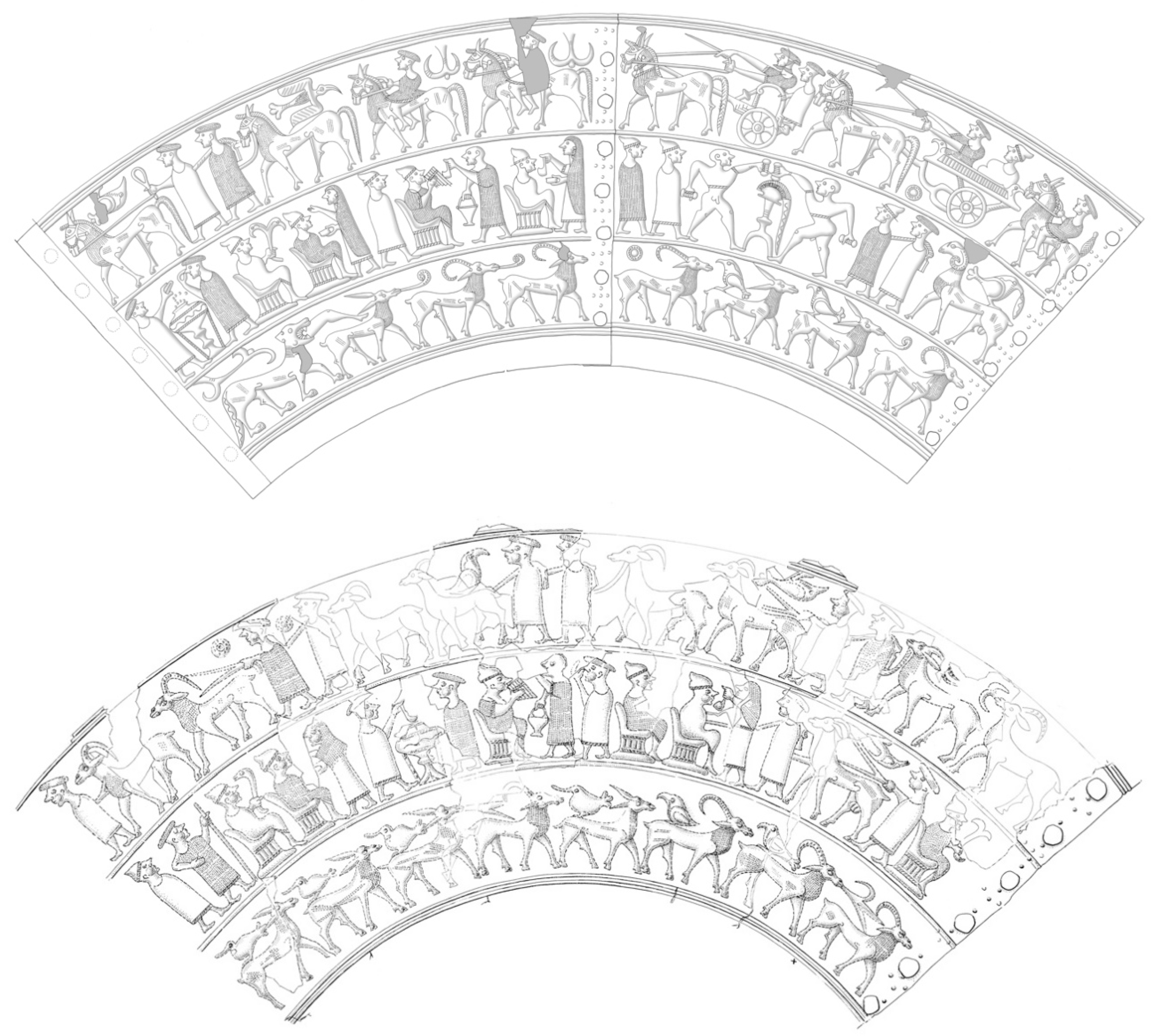
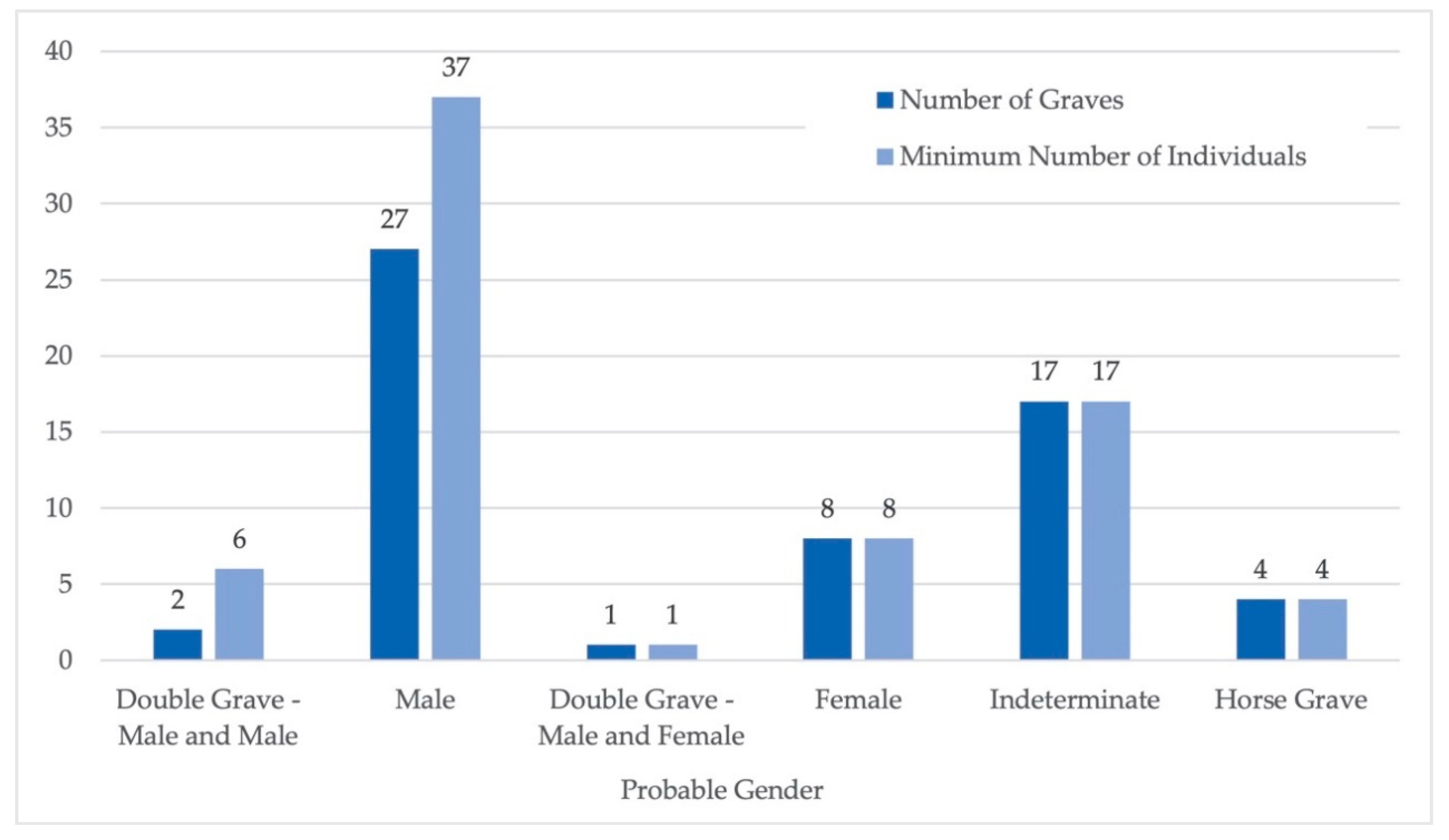
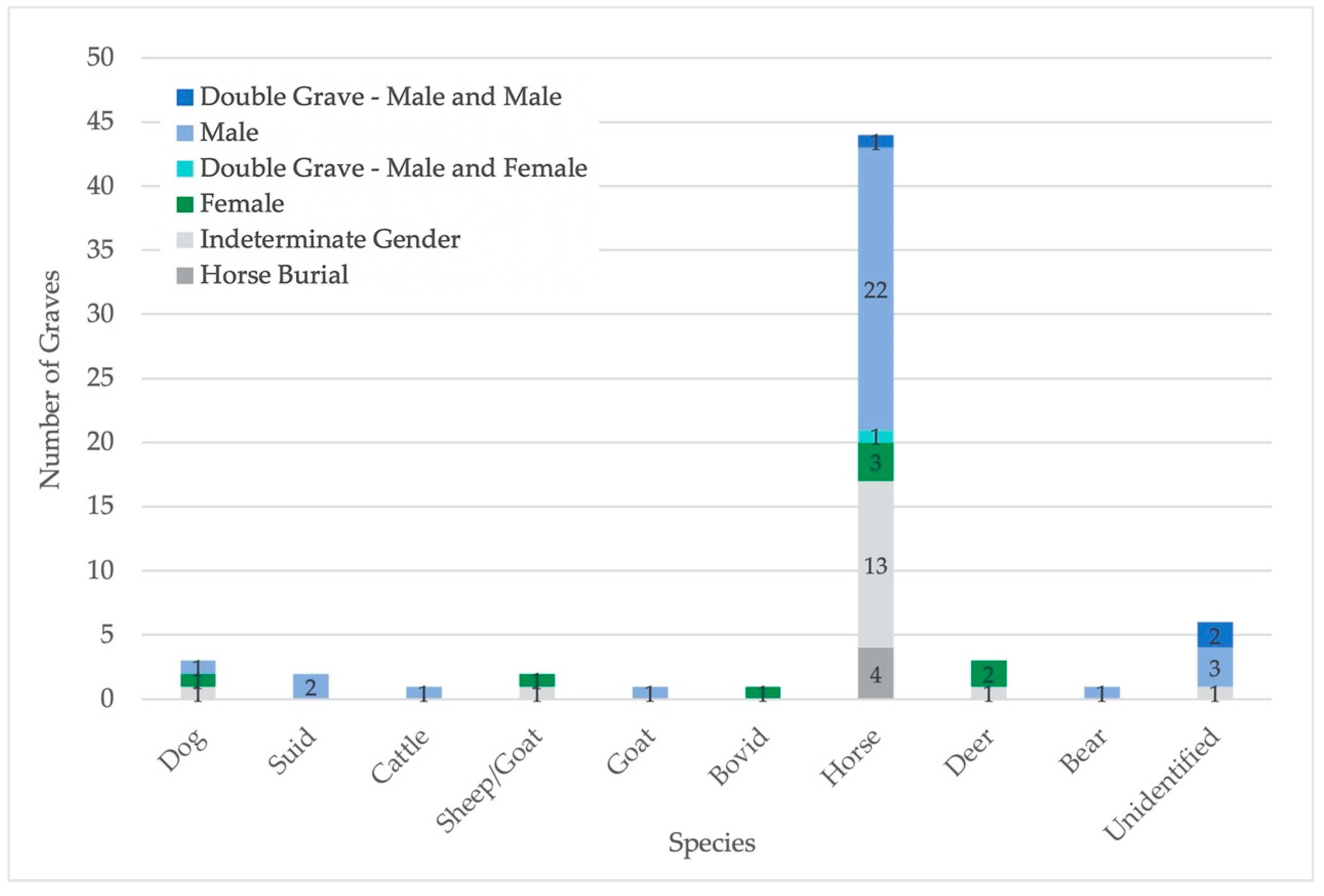

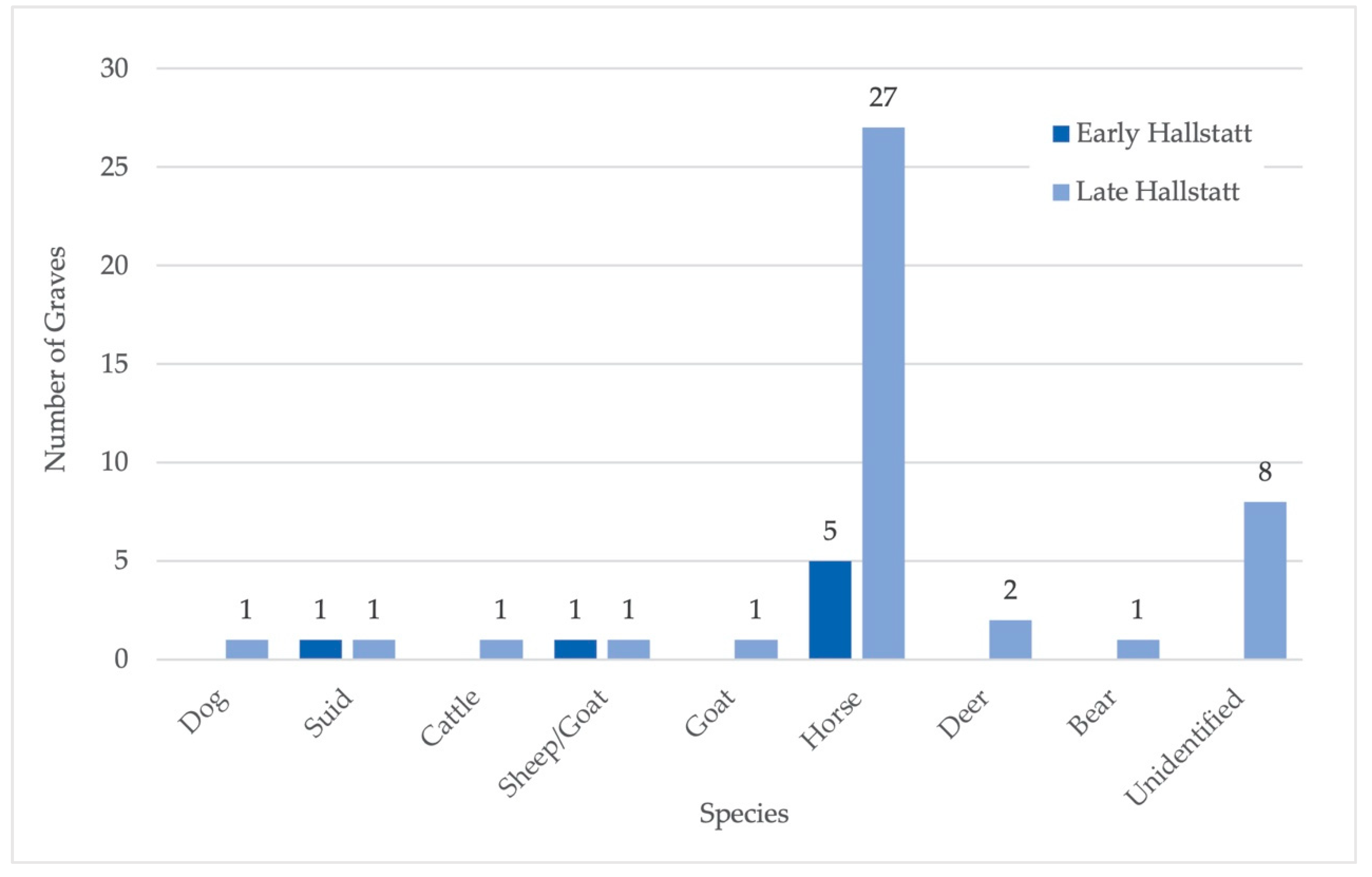
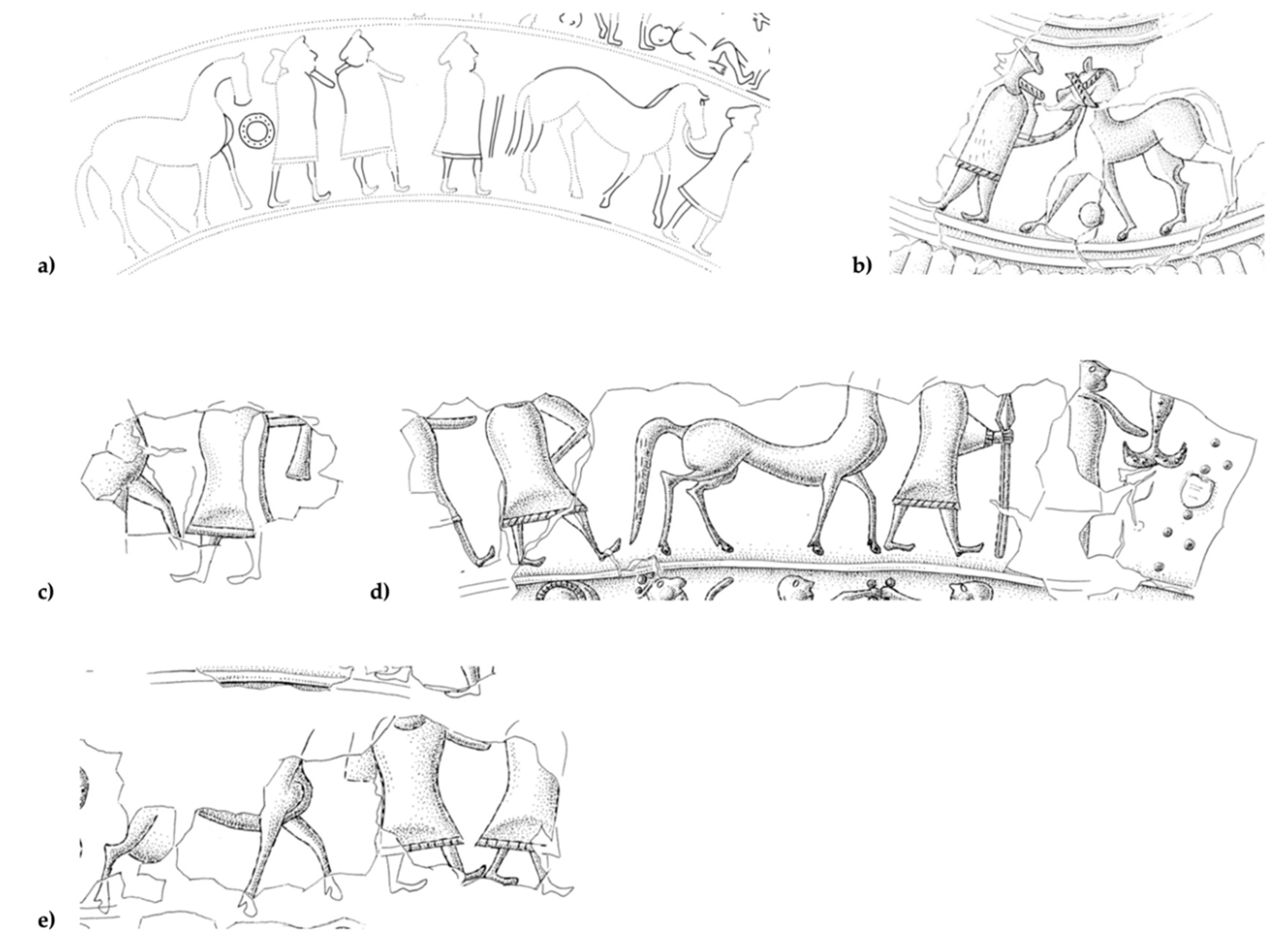
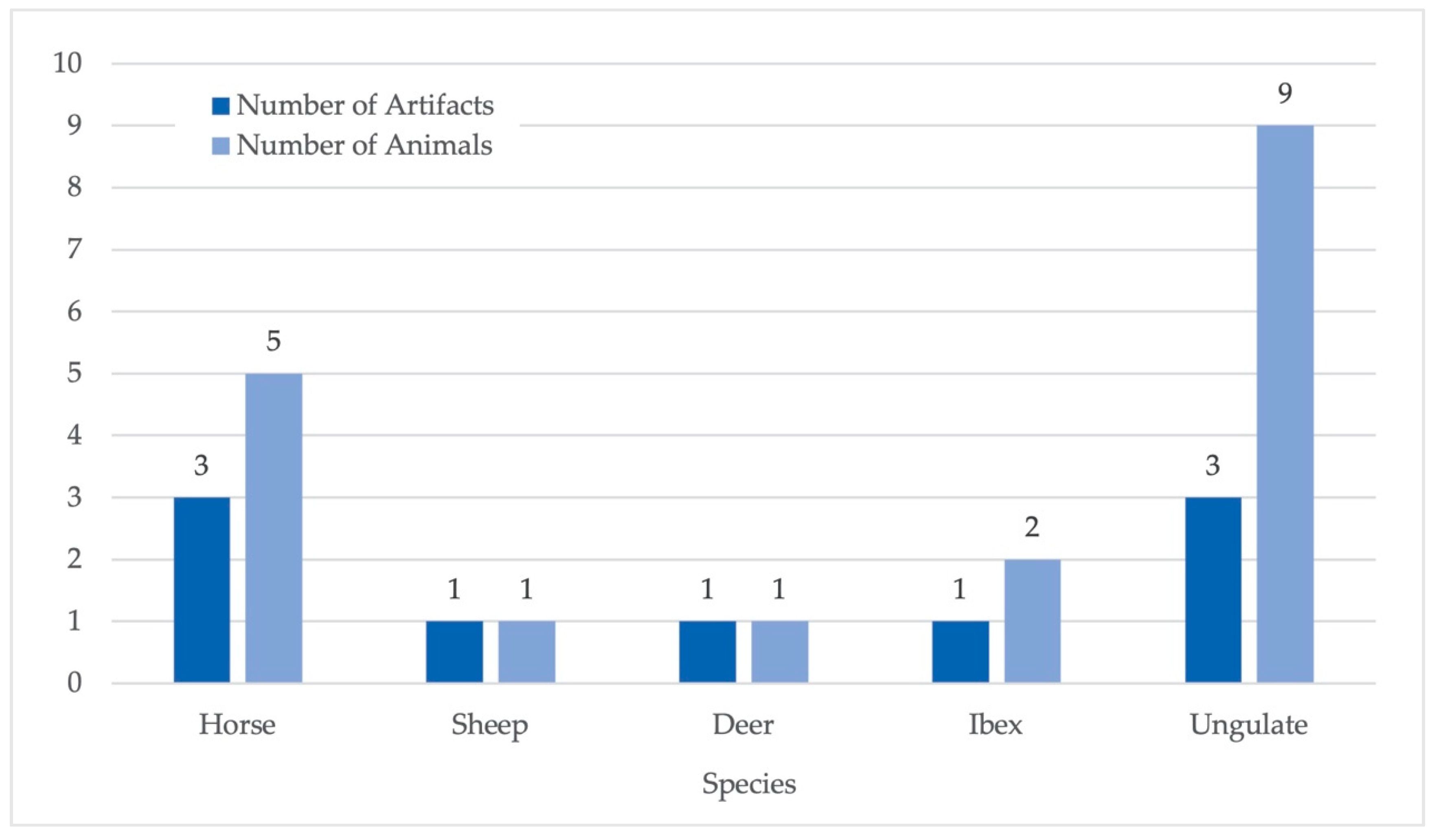
© 2020 by the author. Licensee MDPI, Basel, Switzerland. This article is an open access article distributed under the terms and conditions of the Creative Commons Attribution (CC BY) license (http://creativecommons.org/licenses/by/4.0/).
Share and Cite
Frie, A.C. Parts and Wholes: The Role of Animals in the Performance of Dolenjska Hallstatt Funerary Rites. Arts 2020, 9, 53. https://doi.org/10.3390/arts9020053
Frie AC. Parts and Wholes: The Role of Animals in the Performance of Dolenjska Hallstatt Funerary Rites. Arts. 2020; 9(2):53. https://doi.org/10.3390/arts9020053
Chicago/Turabian StyleFrie, Adrienne C. 2020. "Parts and Wholes: The Role of Animals in the Performance of Dolenjska Hallstatt Funerary Rites" Arts 9, no. 2: 53. https://doi.org/10.3390/arts9020053
APA StyleFrie, A. C. (2020). Parts and Wholes: The Role of Animals in the Performance of Dolenjska Hallstatt Funerary Rites. Arts, 9(2), 53. https://doi.org/10.3390/arts9020053





